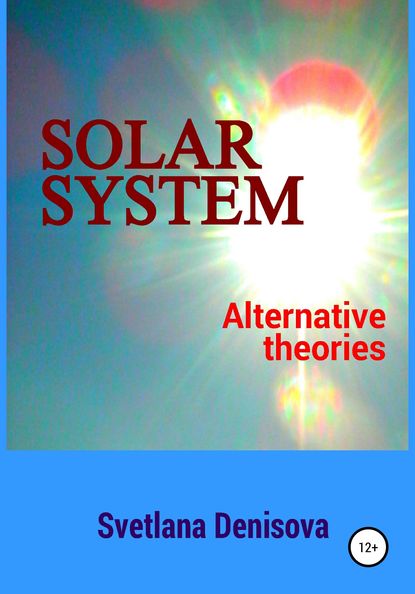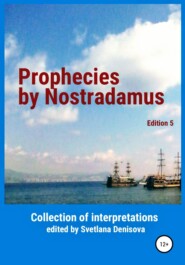По всем вопросам обращайтесь на: info@litportal.ru
(©) 2003-2024.
✖
Solar system / Alternative theories
Автор
Год написания книги
2017
Настройки чтения
Размер шрифта
Высота строк
Поля
Saturn Н-96%, Не-3%, р-0.687 g/cm
;
Uranus Н-83%, Не-15%, р-1.27 g/cm
;
Neptune Н-80%, Не-19%, р-1.638 g/cm
.
To understand the cause of the destruction of the planets, the Table 4 "Satellites of planets" was formed. The data for the table was taken from the encyclopedia Wikipedia. It is often changing, so the values in Table 4 may not reflect the latest changes. This table does not make analysis of the remote satellites of gas planets. They are grouped according to the proximity principle and orbits similarity. Each group is given the name of the largest satellite in it. Destroyed satellites highlighted in blue color, the moons (the spherical satellites) – in pink color.
Table 4. Satellites of the planets of the Solar System
* Synchronized – always turned to the planet by the one side
Pink color – planetary satellites (moons)
Blue color – fragments of the destroyed space object
AB – asteroid belt
e – eccentricity
i – inclination of the orbit
Roche limit calculated by the simplified formula: R
* 2.46 – R
* 2.46, where R
– planet radius before destruction, R
– after destruction (Table 3).
As it can be seen from Table 4, all the fragments of destroyed satellites are in zone of rings, on orbits nearest to planet, in Roche limit (blue color). All gas giants, behind a zone of destruction, have moons (pink color), and then the others satellites. Probably, the destroyed satellites were also the moons.
Consequently, the nearest moons, having the descending orbits, have reached the Roche limit and were crushed by the force of gravity.
Probably, it was a powerful explosion. The moon's core and magma fell on the planet, destroying its crust. They made up a large part of the moon mass. The volume of the planet has increased very rapidly. A core was not destroyed and preserved a spherical shape of a planet. The fragments of the satellite's crust have scattered to the nearby orbits. Small fragments, dust, sand and ice have formed rings. The most powerful explosion near Saturn has formed rings of 480 thousand km wide. The weakest explosion near Neptune has formed rings of only 63 thousand km wide. Large fragments in zone of rings attracted to itself particles and, as a result, the gaps emerged in the rings.
Jupiter has 4 large fragments of the shattered crust in the zone of the rings (92-226 thousand km): Metis, Adrastea, Amalthea (https://ru.m.wikipedia.org/wiki/%D0%A4%D0%B0%D0%B9%D0%BB:Jupiter%27s_moon_Amalthea_photographed_by_Galileo.jpg) and Thebe. The destroyed satellite can be called Amalthea, as it is the largest fragment. They have a total mass ~2.6*10
kg. It is only the part of the destroyed celestial body. A significant part of the mass is in the rings, which are dispersing in the course of time, falling to the planet and to the satellites in the zone of rings. Another part of the moon's mass, in the form of core and magma, probably, fell on the planet. In comparison with the other three destroyed planets, Amalthea has the minimum weight and the minimum number of fragments. It can be assumed, that the destructed satellite was small, but it was sufficient to destroy the crust of a giant Jupiter.
Saturn has the most powerful and the widest rings of 67-460 thousand km, visible in telescopes. Ten fragments of the destroyed satellite are in the zone of the rings. Their total mass is ~2.8*10
kg. The destroyed satellite can be called Janus by the name of the largest fragment. Neptune and Uranus have more fragments. However, the largest moon was crushed near Saturn. To confirm this, the following arguments can be cited:
– a large part of the mass is in huge rings;
– Saturn's destruction is the greatest of all four gas giant (the lowest density, the greatest amount of hydrogen);
– 4 whole moons in a zone of rings gathered a part of a mass (particles) from the rings;
– Lapetus has a powerful equatorial ridge, which, perhaps, has been gathered in the zone of the rings.
Apart from the fragmentary satellites, 4 moons: Mimas, Enceladus, Tethys, and Dione there are in the rings of Saturn.
Mimas is the smallest moon in the SS. It is interesting, that the destruction of Janus destroyed the shell of Saturn, but it did not destroy the moons in higher orbits. Among all intact moons, Mimas has the nearest orbit to the planet. Apparently, at the time of the explosion Janus, Mimas was subjected to a powerful bombardment. It has a lot of impact craters. lapetus (https://ru.m.wikipedia.org/wiki/%D0%AF%D0%BF%D0%B5%D1%82_(%D1%81%D0%BF%D1%83%D1%82%D0%BD%D0%B8%D0%BA)#/media/%D0%A4%D0%B0%D0%B9%D0%BB%3AIapetus_as_seen_by_the_Cassini_probe_-_20071008.jpg) is the most unique moon. It has 3 characteristic features: a giant equatorial ridge, a black leading side and a white back side, and the highest orbit among the moons.
Uranus has rings closest to the planet, located at the distance 38-98 thousand km. This can be explained by the fact, that before destruction Uranus was less, than the other three planets. Consequently, Roche limit is nearest to him. It has 11 fragments of the destroyed satellite, more than the other three gas giants. The destroyed object can be called Puck (https://upload.wikimedia.org/wikipedia/commons/b/b6/Puck.png) , by the name of the largest fragment. The total mass of the fragments is ~6.9*10
kg, the second after Neptune. The rings of Uranus are insignificant in comparison with Saturn. This means, that the explosion was not strong. Probably, Puck was very old, and a little magma there was inside, and the crust was very thick. The more powerful explosion gives more small particles (rings). Presumably, numerous fragments have gathered particles from rings, or they were scattered. From all other SS planets Uranus is distinguished by the fact, that it "turned on its side" with its entire system of satellites.
Neptune has a faint system of rings 42-63 thousand km. It has 5 fragments of the destroyed satellite, with total mass ~9.3*10
kg. It is a largest mass from the all crushed satellites. It can be called Larissa, by the name of the largest fragment. Despite the largest mass of fragments, Neptune has minimum destruction among four gas planets?! It has the highest density and the slowest rotation – 16 hours/day, other gas planets – 10 hours/day. To explain this, we can assume, that the destroyed satellite was not moon (not of planetary type), or its crust was thick and internal magma was little, and the explosion was weak. The mission "Voyager 2" studied satellites of Neptune in 1989. Proteus (https://upload.wikimedia.org/wikipedia/commons/8/83/Proteus_%28Voyager_2%29.jpg) – a large non-spherical satellite has an equatorial ridge, possibly, assembled from rings. Judging by Proteus, the rings were more wide and reached its orbit. Neptune has only 1 moon – Triton. It is the most remote satellite having eruptions.
The Asteroid belt is the destroyed planet Phaeton, between the orbits of Mars and Jupiter. Perhaps, here the biggest catastrophe in the SS occurred. The planet was shattered into pieces, forming a belt of fragments of various shapes and sizes and a segmented ring of sand and dust. The moon Ceres (https://www.google.ru/search?q=%D1%86%D0%B5%D1%80%D0%B5%D1%80%D0%B0&newwindow=1&client=%7BCID%7D&dcr=0&prmd=inv&source=lnms&tbm=isch&sa=X&ved=0ahUKEwjXwZ3tiv_XAhXJNJoKHYbFCUEQ_AUIESgB&biw=1024&bih=600#imgrc=6zG-ftEUXf7YpM:) and several other satellites of non-lunar type remained intact on Phaeton’s orbit. The largest objects of the belt of asteroids are: Vesta, Pallada, Gigeya. Now there is a generally accepted view, that the Asteroid Belt could not have been a destroyed planet. As an argument, a small total mass of fragments is given. However, not all fragments are detected, but, probably, only the largest ones. There is much more of smaller fragments, but they are harder to find and measure. Has anybody taken into account their mass, the mass of the segmented ring as well as the mass of fragments ejected from orbit? Most likely, the mass of this planet was comparable to the mass of Mars. Another argument against the theory of planet destruction is the presence in the Belt of objects, which judging by their properties can not belong to one satellite. There are 2 explanations for this: either the Phaeton has collided with another space body and both have shattered, or this planet, apart from Ceres, had other satellites of a non-planetary type.
Varuna (https://upload.wikimedia.org/wikipedia/commons/f/f7/Varuna_artistic.png) and Haumea are dwarf planets of the Kuiper belt (see Table 5). They have a very elongated ellipsoidal shape and very fast axial rotation – 3-4 hours/day. From this one can make an assumption, that their crust was destroyed, and they are gas planets.
Perhaps, there was also a small planet in the SS – the first from the Sun. This hypothetical planet can be called Lara. She was wife of Mercury in ancient Greek mythology. If this assumption is true, then it was completely destroyed. A belt of fragments and dust can be on the orbit of 30-36 million km. Probably, it is difficult to detect it in such proximity to the star, in its dazzling light.
It is possible to assume, that Earth was on the verge of destruction too. Most likely, it was when the continent Gondwana broke up and Atlantic Ocean was formed. Indians have a legend: once, a fire has erupted from the Earth. Earth stopped, turned over twice, and then began to spin as mad. Apparently, a very rapid rotation in that time saved its solid crust from complete destruction.
All these global catastrophes and destruction can not occur simultaneously. This requires a long period of time; therefore, the SS is very-very old.
4. Appearance of sunspots
There are different hypotheses about the origin of sunspots. Nowadays the most common accepted hypothesis best reflected in the electronic encyclopedia Wikipedia (https://en.m.wikipedia.org/wiki/Sunspots)
. Here the appearance of sunspots is explained as perturbation of some sections of magnetic field of the Sun.
Here the appearance of the sunspots is explained by falling of different space bodies to the Sun’s surface. From this point of view, the magnetic field perturbation is not a reason for the appearance of sunspots, but on the contrary, is a consequence.
It has long been known, that the meteorites and other celestial bodies often fall on planets and satellites. The Earth and other planets are well protected from such "bombings" by atmosphere, in which the majority of small falling objects burn down. The moons without atmosphere have a lot of impact craters. For example, Mimas, moon of Saturn, is almost completely covered with craters from tiny to the giant ones.
The Sun is not an exception, on the contrary, because of its giant attraction, it is more often exposed to such falls. But unlike the moons, where an every falling forms a crater forever, the fire on the Sun surface deletes all traces of the falls over time. Not all falling objects can form sunspots. Most of them, having a small size or consisting mainly of ice, or loose rocks, burn up before reaching the Sun surface. Only the largest of falling objects leave a temporary spot.
Almost all the features of sunspots can be explained by the fall of the celestial bodies.
1. "They (sunspots) are regions of reduced temperature…" [Wikipedia]
The absence of fire makes these areas relatively less hot, than the rest of the Sun surface. The temperature of falling objects is much below the Sun surface temperature. When approaching the Sun, they are warming up quickly, and their surface begins to burn.






